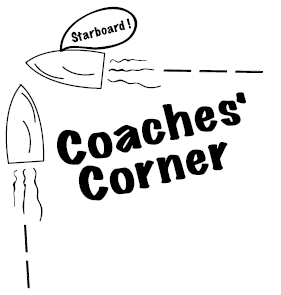By Clemmie Everett
Once you know your team racing combinations and plays, you need to know how to create those combinations through passbacks and mark traps.

As its name implies, a mark trap involves slowing an opponent at a mark to let a teammate move ahead of you, while a passback takes place on a leg of the course while you are away from marks. Often you will be using the rules at marks to force your opponent to slow down, so be sure that you are confident in your understanding of Rule 10 (Starboard/Port), Rule 11 and Rule 17 (Windward/Leeward), and Rule 18 (Mark Room).
To set up a windward mark trap, you will stop your boat on starboard tack on the starboard layline at the edge of the zone, so no one has mark-room on you (note that the zone is two boatlengths in team racing). If an opponent behind tries to approach on port tack, you can force the opponent to avoid you and prevent them from rounding the mark. If an opponent approaches from behind and goes to windward, you can luff them up. If an opponent tries to go to leeward, their rights will be limited and you can block them from rounding. Ideally, you will be able to slow your opponent enough that your teammate can come from behind and sail past both of you. Your teammate needs to be careful not to be caught up in the trap that you are setting. In fact, if an opponent is trapping you, your response should always be to stop your boat behind your opponent (not overlapped!) and execute a trap on the opponent behind you.
A leeward mark trap can seem more intimidating to set up, but it rests on the same foundations as a windward mark trap. The most common mistake inexperienced team racers make when setting leeward mark traps is to stop on port right next to the mark. In fact, you want to stop your boat on the starboard layline at the edge of the zone, a place you don’t often visit in fleet racing. By setting your self up here, no one has room on you, and you leave yourself some space to maneuver. Should an opponent try to work inside of you, you can simply shut the door – no room! More likely, an opponent will come barreling in on the outside of you, in which case you are inside, starboard, and leeward – a powerful combination that will allow you to luff your opponent up, prevent them from rounding the mark, and open a slot for a teammate to go through. Once your teammate is through, you can jibe and round the mark, leaving your opponent behind. A caveat of the leeward mark trap is that it’s easy to sail your opponent outside of the zone, and when you turn to sail back in, find that you have allowed another opponent to gain an inside overlap, so be careful!
Of course, you should not wait until a mark to be aggressive and move your teammates ahead of opponents – you can also perform a passback on any leg of the course. On an upwind leg, position yourself to windward and ahead of your opponent in order to block their wind. Once there, you can let your jib luff to disrupt the wind that will reach their sails and slow them down significantly. You’ll know that your positioning is right if the luffing jib points right at their sails. Meanwhile, a teammate can sail at full speed and pass you both.
Downwind passbacks are more difficult because your opponents behind can blanket you. However, you still have a wide array of tools to attack your opponents. Set yourself up on port and slow your boat down by trimming in the sails or luffing the jib. If your opponent comes from behind and overlaps you to windward, luff them up. If your opponent overlaps you to leeward, jibe onto starboard (remember that you must abide by Rule 15 and provide room to keep clear). Your opponent will have no choice but to jibe, and now you have luffing rights! Luff them up and let your teammate sail right through.
What should you do if an opponent attempts a passback on you? Well, the first step is to anticipate the passback and not sail yourself into a vulnerable situation. More importantly, however, you want to be the more aggressive team and make the first move. Before your opponent can slow you, slow the opponent behind you. Team racing is complex. There’s a lot to learn and a lot to talk about, but the best way to figure it out is to go out and give it a try. See you on the racecourse!
Clemmie Everett is the Assistant Sailing Coach at Rye Country Day School in Rye, NY and the Sailing Director at Noroton Yacht Club in Darien, CT.



